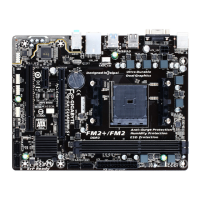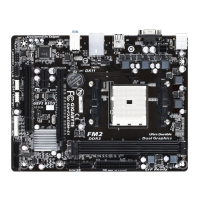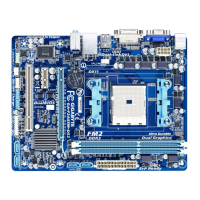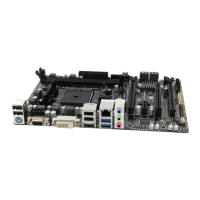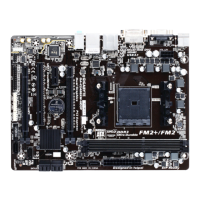- 32 -
InstallingtheSATARAID/AHCIDriverandOperatingSystem
With the correct BIOS settings, you are ready to install the operating system.
A. Installing Windows 8.1/7
(The following instructions use Windows 8.1 as the example operating system.)
Step 1:
You need to install the SATA RAID/AHCI driver during the OS installation. Use an alternative system to copy
the SATA RAID/AHCI driver from the motherboard driver disk to a USB ash drive. Copy the Hw8_A88 folder
under BootDrv in the driver disk.
Step 2:
Boot from the Windows 8.1 setup disk and perform standard OS installation steps. When the screen requesting
you to load the driver appears, select Browse.
Step 3:
Then browse to the USB ash drive and select the location of the driver. The locations of the drivers are as follows:
RAID driver for Windows 8.1 32-bit: Hw8_A88\RAID\x86
RAID driver for Windows 8.1 64-bit: Hw8_A88\RAID\x64
AHCI driver for Windows 8.1 32-bit: Hw8_A88\AHCI\W8
AHCI driver for Windows 8.1 64-bit: Hw8_A88\AHCI\W864A
For Windows 7, browse to the Hw7_A88 folder.
Step 4:
When a screen appears, select AMD-RAID Controller and click Next to load the driver and continue the OS
installation.
B. Installing Windows XP (32-bit)
Before installing Windows XP, connect a USB oppy disk drive to your computer rst because you need to install
the SATA RAID/AHCI driver from a oppy disk that contains the driver during the OS installation. Without the
driver, the hard drive(s) may not be recognized during the Windows setup process. First, copy the driver from
the motherboard driver disk to a oppy disk. Refer to the methods below.
Method A:
• For the AMD A68H, copy all les in the \BootDrv\Hxp folder to your oppy disk.
Method B:
Steps:
1: Use an alternative system and insert the motherboard driver disk.
2: From your optical drive folder, double click the Menu.exe le in the BootDrv folder. A Command Prompt
window will open similar to that in Figure 2.
3: 3: Insert the blank formatted disk (if you're using a USB oppy disk drive, make sure it is designated as
drive A). Select the controller driver by pressing the corresponding letter from the menu and press <Enter>.
For example, from the menu in Figure 2, for the AMD A88X, select 6) hseries AHCI/RAID<A85>for XP.
Your system will then automatically copy the driver les to the oppy disk. Press any key to exit when nished.
3. First, select a RAID mode and press <Enter>. The selections available depend on the number of the hard drives
being installed. Then follow the on-screen instructions to specify the array size. You can select All available
space to use the maximum size allowed or use the up or down arrow key to adjust the size and press <Enter>.
4. Select a caching mode. Options include Read/Write, Read Only, and None. Then press <Enter> to proceed.
5. Finally, a message which says "Conrm Creation of Array" will appear. Press <C> to conrm or <Esc> to
return to the previous screen. To exit the RAID BIOS utility, press <Esc> and then press <C> to conrm.
Deleting an Array
The Delete Array(s) menu option allows for deletion of disk array assignments.
1. Select Delete Array(s) in the Main Menu and press <Enter>.
2. In the Arrays section, press the <Insert> key on the array you want to delete and then press <Enter> to proceed.
3. When prompted to conrm, press <C> to continue the deletion or <Esc> to cancel.

